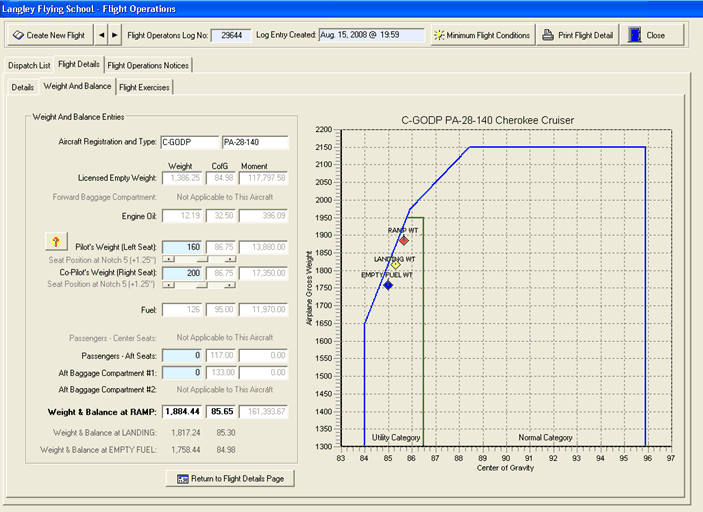PREPARING FOR A FLYING LESSON
The following checklists are simply designed to help keep yourself organized when preparing for a training flight. 1
First Flight Lesson Preparation
- Review the Flight Rules and Safety Precautions, which are effectively the core safety rules for the school's flight training operations. While much of the content will be familiar, you have to start somewhere, and you will at least be familiar with the activities and concepts which make up the rules.
- Review the "Pre-flight Inspection" checklist for your aircraft, as outlined in the Pilot Operating Handbook--your Flight Instructor will begin right away with getting you involved in this crucial pre-flight task required by the pilot.
- Read and study the first part of your Flight Training Manual up to and including Attitudes and Movements--the name of your first lesson.
- Read and study the first part of the Langley Flying School Flight Training Handbook, also up to and including Attitudes and Movements.
- Read and review the Flight Operations Notices, which are published on the school's website--these are notices to student crucial for operational safety.
- Read and review the Flight Operations Safety Threat List, so you are familiar with key safety issues facing student pilots and the mitigation measures in place to minimize their threat.
- Read and become familiar with the LFS Operations and Fleet Status Report, which is review on a daily basis by operational staff and updated as required.
Pre-flight

- Begin with a review of the current and forecast flight conditions published by NavCanada, which should include a review of the TAF for Abbotsford Airport—CYXX (the nearest airport for which a TAF is published), the GFA for the Pacific Region, and Local West Coast GFA (the Soiuth sector). These are available through links the Observation and Forecast page of the NavCanada Aviation Weather Website.
- Contact the Kamloops Flight Information Centre via toll-free telephone at 1-866-541-4101 and request a "briefing" for your training flight (see discussions regarding a FSS briefing).
- Examine the Journey Log for your aircraft with specific concern to some key items. Note the current "air time" on the aircraft, so that you confirm the airtime shown on the LFS dispatch software—Flight School Record--tis correct. Go to the back of the Journey Log and examine the "Deferred Defects List" and note any defects that have been deferred and are therefore outstanding—this too will be compared to the list depicted in the Flight School Record dispatch software.
- Conduct a thorough pre-flight inspection (walk-around) of your aircraft.
- Log onto the LFS dispatch system and read and sign any current Flight Operations Notices—note that these are also published online, and can be read before your training flight booking.
- Fill-out and complete the electronic "new flight" in Flight School Record software, including notation of the oil, fuel, estimated fuel time, takeoff Centre of Gravity and Weight, Hobbs, anticipated departure time and estimated length of the flight; be sure to include the planned exercises.
- Examine the "Aircraft" data depicted in the Flight School Record 2 to ensure your scheduled aircraft is “operational”. Confirm that the "time to next inspection" matches the Journey Log (if it does not, advise your Flight Instructor, confirm that the "Deferred Defects" list matches the Journey Log record, and make sure the “out-of-phase” maintenance tasks time limits (limits pertaining to recurring maintenance on such tasks as annual fire extinguisher certification, annual survival kit certification, or bi-annual pitot-static system certification. Out-of-phase maintenance tasks can be based on calendar date on aircraft airtime.
- Calculate the planned takeoff weight and balance for your aircraft by inserting the crew passenger weights.
- Complete the student's electronic signature checklist, and sign off your flight.
- Manually complete the information required on the Flight Operations Board in the Ready Room. If passengers are planned for the flight, ensure the passenger name and telephone number is listed on the board.
- Ensure that the Journey Log is placed on-board the aircraft.3
- Meet with your Instructor for a pre-flight briefing.

Post-Flight
- Ensure the aircraft is secured.
- Complete the Post-flight items on the Flight Training Operations Log, including time up, time down, and shutdown Hobbs.
- Complete the Journey Log.
- Complete the entry in your Pilot Logbook.
- Ensure the accounting procedures associated with your flight are completed.
- Meet with your Instructor for a post-flight debriefing.
- Obtain instruction concerning the planned exercises for the next flight, including reading and study assignments.
References
1 These checklists are the results of comments made by one of our graduates, Tom Larkin, who thought it would be useful to have a list of tasks required to be completed before and after a training flight—the idea being that for students who are not familiar with the process, this can all seem quite confusing. We quite agree with Tom.
2 See the discussions pertaiining to Airworthiness, as well as Aircraft Defects.
3 The aircraft documents—Certificate of Registration, Certificate of Airworthiness, and Equipment List (Weight and Balance)—are kept in the cockpit of LFS aircraft.. These documents must be on board the aircraft during every flight; the Journey Log Book for each aircraft, however, need only be on board the aircraft when a landing is planned at an airport other than the airport of departure—so technically, the Journey Log Book does not have to be on board training flights that satisfy this requirement. Don’t get confused, though, as the Pilot Operating Handbook must always be on board and available to the pilot.
.jpg)

